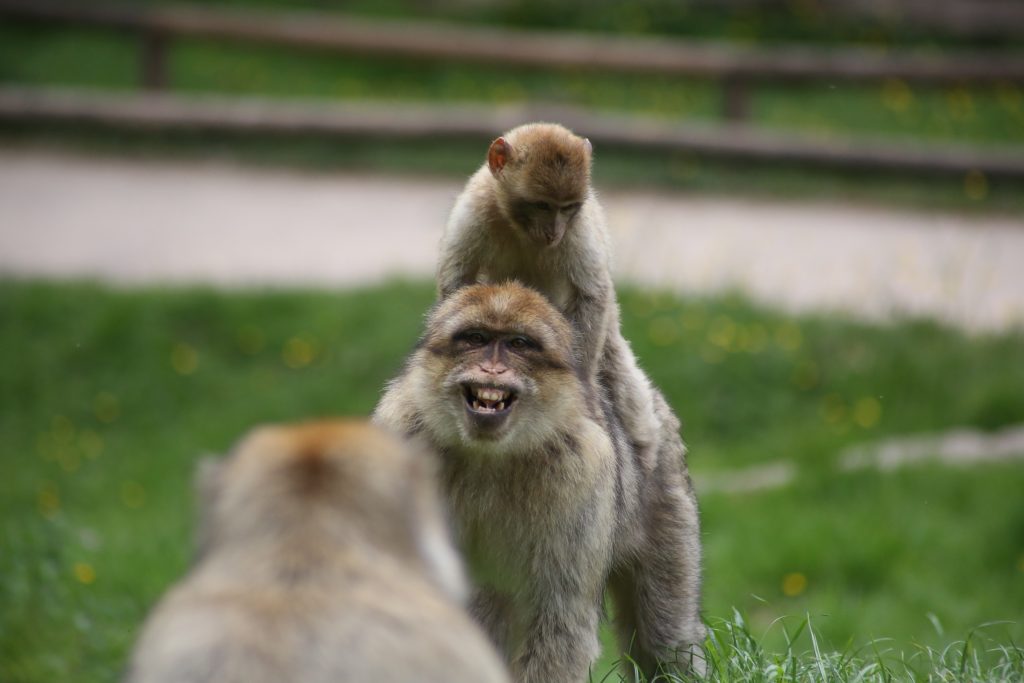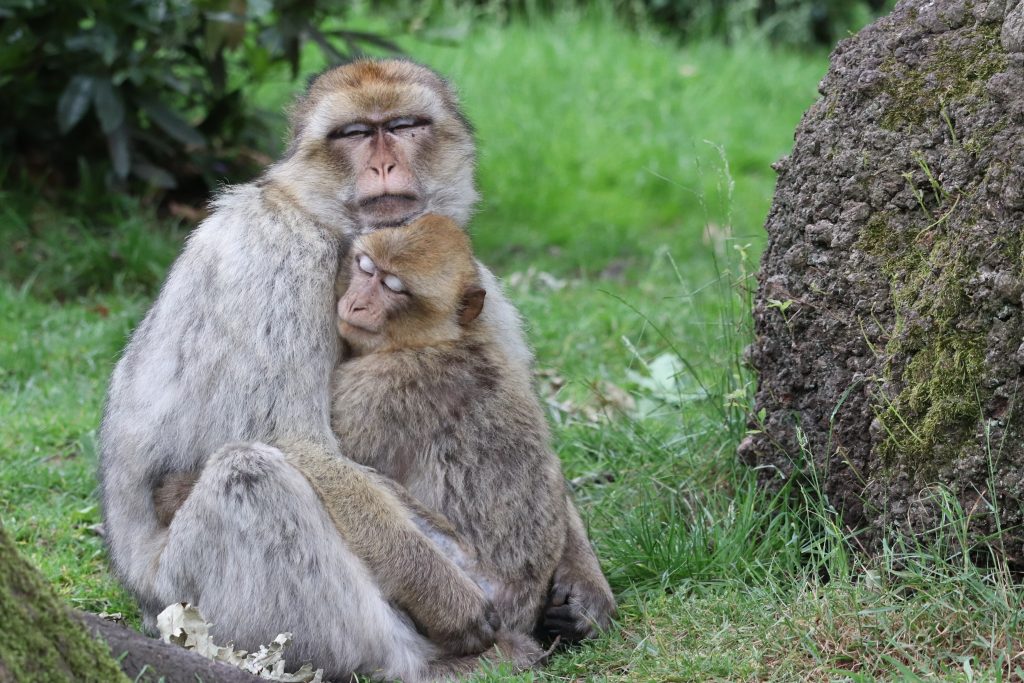
New babies are an exciting addition to any primate social group, but baby Barbary macaques serve an extra function in primate social groups as a source of currency.
I know what you might be thinking — how could a living individual serve an inanimate function? While traditionally we think of currency as a token or other inanimate object with which we assign value and use in transactions of goods and services, baby Barbary macaques can serve the same function in social “transactions”.
Most notably, baby Barbary macaques are used by male Barbary macaques to de-escalate otherwise aggressive or antagonistic interactions [1]. In moments that are particularly tense, a male Barbary macaque often reaches out and grabs a nearby baby to hold, and sometimes offer, to the aggressive social partner.

The majority of these social interactions play out like the photograph above. In addition to infant carrying, the submissive Barbary macaque will also make a facial expression called a ‘fear grimace’ that lets the other individual know [s]he (the ‘fear-grimacer’) is not a threat. Barbary macaques have a whole suite of facial expressions to communicate their emotional states to other individuals. In these interactions, the most common among them are the fear-grimace (as illustrated above) and the lip-smack, which is an affiliative gesture meant to reconcile post-conflict interactions.
As compared to other primate species, male Barbary macaques in general spend considerably more time interacting with babies than males in most other Old World primate species. For decades, theorists have argued over two theories explaining why this may be: the agonistic buffering hypothesis, and the male care hypothesis.
The ‘agonistic buffering hypothesis’ is more in line with the social interactions described at the beginning of this post. In other words, males spend a lot of time with baby Barbary macaques to help facilitate social interactions. Imagine: things between you and another monkey getting tense? Grab the nearest baby. Everyone loves babies!
But other primatologists believe this is not the case. A few years later, Taub argued that the males were assisting in infant care, thus, the ‘male care hypothesis’. From his time in the field, he observed that males prioritized spending time with some infants over others, and believed that this was likely due to kinship. In other words, male Barbary macaques are invested in the well-being of their offspring. As handling of the offspring increases their likelihood of survival and social success, male Barbary macaques are just investing in the succession of their own genes.

This latter hypothesis is intuitive and would be fine, except that this is often not the case. More recent studies conducted on Barbary macaques have demonstrated that males do not often claim paternity of the infants they handle [4, 5]. Instead, by handling babies, Barbary macaques win social favor with female Barbary macaques, securing a higher-likelihood for future mating opportunities [5]. This care-then-mate strategy is counterintuitive to the mate-then-care strategy employed by other species, where both parents contribute to offspring care. Some have characterized the explanation of this behavior as the ‘mating effort hypothesis’ [6], though it has received less support than the aforementioned two hypotheses for infant handling in male Barbary macaques.
It is important to note that the ultimate, albeit subconscious, goal of each male Barbary macaque is to pass on his genes. Each hypothesis described above explains what benefits the male might accrue by forming strong dyadic bonds with infants within the group. While it is *highly* unlikely that each male Barbary macaque is taking into consideration the many fitness benefits this relationship may afford him, it is easy for us to think about the different ways that each hypothesis illustrates fitness benefits the male is granted by spending time on these interactions.
Hopefully you enjoyed this post on baby barbary macaques. Critiques and comments are extremely useful and help me grow as a science writer, so please feel free to send along any thoughts you might have. Thanks for following along!
REFERENCES
[1] Deag, J. M., & Crook, J. H. (1971). Social behaviour and ‘agonistic buffering’ in the wild Barbary macaque Macaca sylvana L. Folia Primatologica, 15(3-4): 183-200.
[2] Van Schaik, C. P., & Paul, A. (1996). Male care in primates: does it ever reflect paternity?. Evolutionary Anthropology: Issues, News, and Reviews: 5(5): 152-156.
[3] Taub, D. M. (1980). Testing the ‘agonistic buffering’hypothesis. Behavioral Ecology and Sociobiology, 6(3): 187-197.
[4] Kuester, J., & Paul, A. (1986). Male‐infant relationships in semifree‐ranging Barbary macaques (Macaca sylvanus) of affenberg salem/FRG: Testing the “male care” hypothesis. American Journal of Primatology, 10(4): 315-327.
[5] Ménard, N., von Segesser, F., Scheffrahn, W., Pastorini, J., Vallet, D., Gaci, B., … & Gautier-Hion, A. (2001). Is male–infant caretaking related to paternity and/or mating activities in wild Barbary macaques (Macaca sylvanus)?. Comptes Rendus de l’Académie des Sciences-Series III-Sciences de la Vie, 324(7): 601-610.
[6] Paul, A., Kuester, J., & Arnemann, J. (1996). The sociobiology of male–infant interactions in Barbary macaques, Macaca sylvanus. Animal Behaviour, 51(1): 155-170.
How interesting! I have noticed that sometimes Male long tailed macaques will kidnap a baby to prevent the males from attacking him when entering a new troop, or to get the mother closer and interested , as in a case I saw, she began grooming the Male in order to get close enough her baby could get a a few mouthful of milk . But among that species it seemed these males were not on any way affiliative with the infants and were essentially using them and keeping them from mom. The case I spoke of the baby just got dirtier and more dehydrated from lack of nursing and maternal access and he starved to death after a few days. This also happens when female LTMs kidnap (and often violently abuse, dragging over rocks overstepping on the head) the infants of lower ranking LTM moms, though the females apparently do this as a dominance display or social punishment for mother, as she is not allowed to take her baby back from a higher rank female and must simply follow at a distance of a few feet and hope the baby gets away or the kidnapper gets bored before their baby gets accidentally injured too much or dehydrates to death.
then the blsck crested macaques have virtually no conflict among them at all! Although I have heard the evolutionary explanation for that as being an abundance of food in their geographical niche.
It’s so amazing how the various subspecies of macaques are so similar in morphology yet so different in ethology.
Thank you for the article.